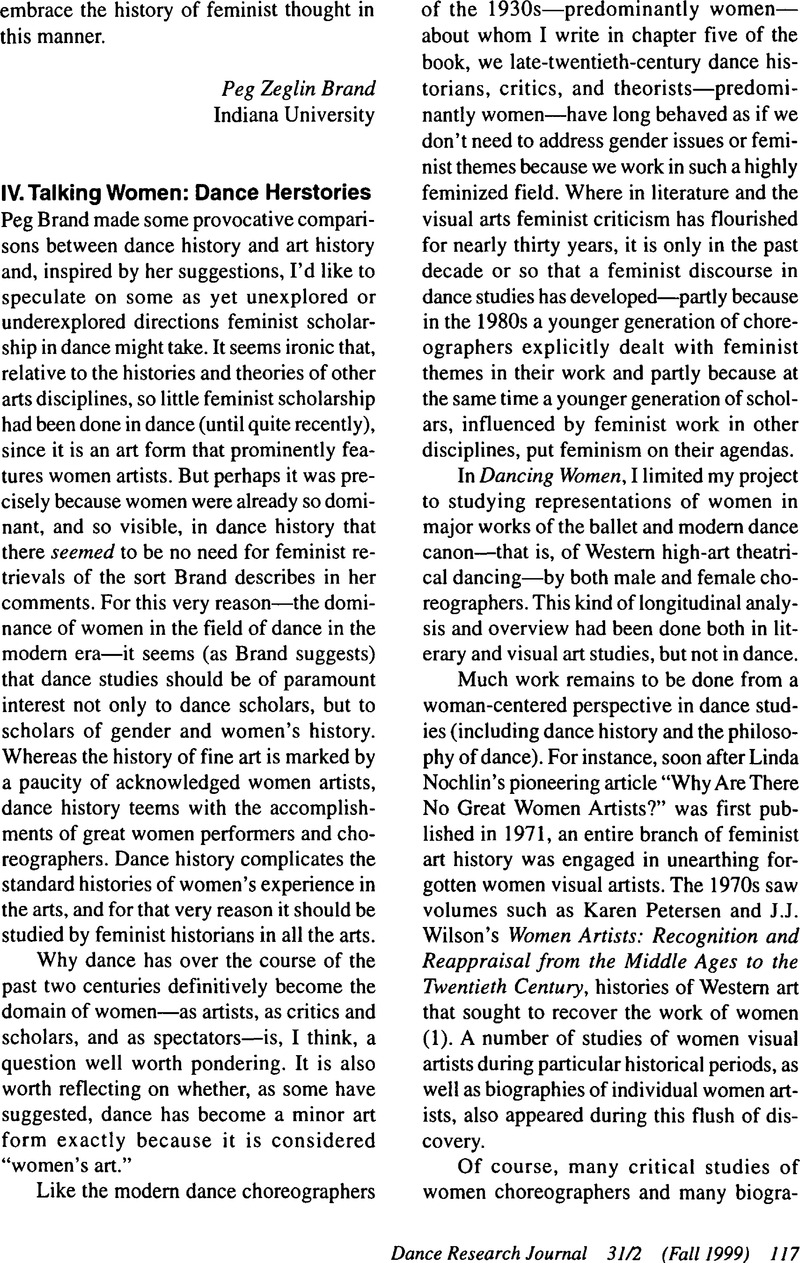Published online by Cambridge University Press: 08 April 2017

1. Petersen, Karen and Wilson, J.J., Women Artists: Recognition and Reappraisal from the Middle Ages to the Twentieth Century (New York: New York University Press, 1976).Google Scholar
2. Lynn Garafola, “Where Are Ballet's Women Choreographers?” University Lecture, University of Wisconsin-Madison, 10 November 1995.
3. Farge, Arlette, “Method and Effects of Women's History,” in Writing Women's History, edited by Perrot, Michelle (Oxford: Basil Blackwell, 1992), p. 15.Google Scholar
4. Daly, Ann, “The Balanchine Woman: Of Hummingbirds and Channel Swimmers,” The Drama Review 31/1 (Spring 1987; T113): 8–21.CrossRefGoogle Scholar
5. Daly, Ann, “Isadora Duncan and the Male Gaze,” in Gender in Performance: The Presentation of Difference in the Performing Arts, edited by Senelick, Laurence (Hanover, NH: Tufts University Press/University Press of New England, 1992), 243.Google Scholar But oddly, Daly's 1987–88 essay “Classical Ballet: A Discourse of Difference,” in which she elaborates her original position on the male gaze, was reprinted in 1997 without any qualification or disclaimer (Daly, Ann, “Classical Ballet: A Discourse of Difference,” first published in Women and Performance 3/2 [1987–1988]: 57–66CrossRefGoogle Scholar and reprinted in Meaning in Motion: New Cultural Studies of Dance, edited by Desmond, Jane C. [Durham, NC: Duke University Press, 1997], 111–119).Google Scholar Daly writes, about the ballerina's rise to prominence on the early Romantic ballet stage, “Even though women's new found pointe work monopolized the balletomanes' attention, the men on stage retained dominance in the representation by presenting and displaying (and ‘creating’) these object-forms as their own possessions. And by identifying with these figures, the male gaze of the spectator was active in creating and possessing—and ‘Ogling’—these female creatures” (p. 114).
6. Daly, “Isadora Duncan and the Male Gaze,” 243.
7. Mulvey, Laura, “Visual Pleasure and Narrative Cinema,” Screen 16/3 (Autumn 1975): 6–18CrossRefGoogle Scholar, reprinted in Mulvey, Laura, Visual and Other Pleasures (Bloomington: Indiana University Press, 1989), 14–26.CrossRefGoogle Scholar Further citations to this essay will refer to the pagination in Visual and Other Pleasures.
8. Mulvey, 21.
9. See Kaplan, E. Ann, “Is the Gaze Male?” in Women and Film: Both Sides of the Camera (New York: Methuen, 1983), 23–35.CrossRefGoogle Scholar
10. 10. Daly, “The Balanchine Woman,” 14, 16, 17.Google Scholar